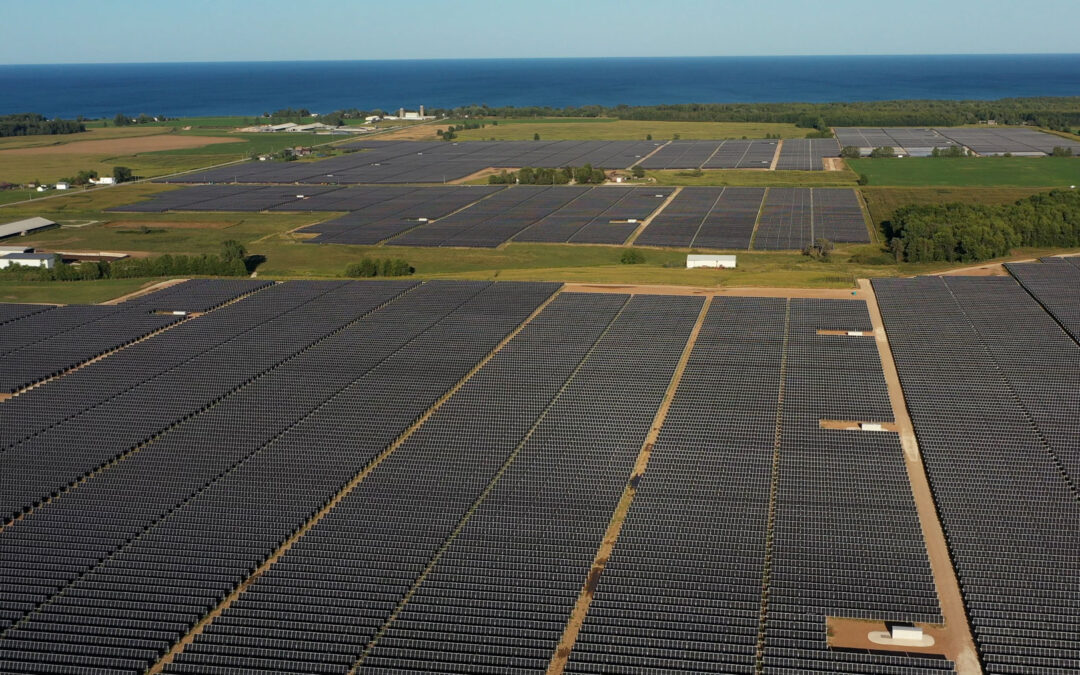
by Michael Vickerman | Nov 15, 2020 | Public Service Commission, Renewables, Solar, Utilities, Utility Scale
The Two Creeks Solar Park, located in Manitowoc County, was energized last week, becoming the state’s largest generating station powered by the sun. Developed by Florida-based NextEra Energy, Two Creeks is jointly owned by two Wisconsin electric utilities: Wisconsin Public Service Corporation (WPS) and Madison Gas and Electric (MGE). WPS owns and operates a 100 megawatt (MW) share of the 150 MW power plant, while MGE has the remaining 50 MW share.
Located next to the Point Beach Nuclear Plant, Two Creeks effectively doubles the amount of solar generating capacity in Wisconsin to 300 MW, and will, over the next six months, produce more electricity than the combined output from all other existing solar systems in Wisconsin. Expected to produce more than 300,000,000 megawatt-hours a year, Two Creeks will generate about one-half of one percent of the state’s overall supply of electricity, which is the equivalent of what 33,000 residences consume annually.
Along with the 300 MW Badger Hollow Solar Farm in Iowa County, Two Creeks received approval from the Public Service Commission (PSC) in April 2019. These two were the pioneering solar farm proposals that navigated through the PSC’s power plant siting process and won approval from the agency. At the same meeting, the PSC granted a joint request from WPS and MGE to acquire Two Creeks.
Since then, the PSC has given the green light to two more solar farms totaling 249 MW in capacity, including NextEra Energy’s 100 MW Point Beach Solar Farm next door to Two Creeks. Point Beach Solar is under construction and should be completed in the fall of 2021.
Construction work on Two Creeks commenced on August 2019, kicked off with a groundbreaking ceremony that drew Gov. Tony Evers and the two utility ceos. Governor Evers’ appearance came less than a week after he issued Executive Order 38, articulating a goal of “ensuring all electricity consumed within the State of Wisconsin is 100% carbon-free by 2050.”
Building Two Creeks was no small undertaking. It involved punching thousands of posts into the ground to support horizontal tracking systems spreading across 800 acres of relatively flat terrain. Mounted on these rotating poles are more than 500,000 panels that follow the sun as it crosses the sky going east to west. Between the first rays of sunlight and the last ones before sunset, these panels soak in the sunshine and convert it to electricity.
A plant like Two Creeks will begin displacing higher-cost power at the moment it is energized, and these savings will grow significantly over the course of its 30-to-50-year life. True, the utilities will need to recover the cost of building the solar farm, somewhere in the vicinity of $195 million. But the savings utilities expect to reap from avoided fossil fuel purchases and pollution control expenditures will more than outweigh their investment in a zero-carbon generation source. Seen in this light, large-scale solar is indisputably the most cost-effective supply option that an electric utility can pursue going forward.
The benefits from Two Creeks extend beyond ratepayer savings. Manitowoc County and the Town of Two Creeks, the jurisdictions hosting the solar farm, expect to reap a combined $600,000 in local aids each year while the project remains in service. That number grows to $18,000,000 over the course of 30 years, which is the projected minimum lifespan of Two Creeks.
Solar is a noncombustible energy resource that does not emit any gaseous emissions or particulates when converted to electricity. Deploying solar at the scale of Two Creeks will capture significant public health and air quality benefits by avoiding emissions that are associated with conventional fossil generation plants. In another PSC proceeding involving a 15O MW solar farm in eastern Wisconsin, the developer anticipates annual emissions reductions in the following categories of pollutants: (1) nitrogen oxide (NOx) emissions by 195,000 pounds; (2) methane (CH4) by 20,000 pounds; (3) nitrous oxide (N2O) by 5,000 pounds; and (4) carbon dioxide (CO2) by 405 million pounds.
Decarbonizing the state’s fleet of power plants is also a job creation strategy. The PSC estimates that somewhere between 200 and 300 jobs were created during the project’s construction window. It’s quite likely that many of the workers involved in the building of Two Creeks are now hard at work constructing the adjoining Point Beach solar farm.
In the annals of Wisconsin electric utility history, Two Creeks represents a noteworthy milestone, as the first solar farm to clear the PSC’s power plant review process and become a valuable addition to the state’s portfolio of power plants. And it took only 18+ months from the crossing of the regulatory finish line for Two Creeks to start sending power into the grid.
Two Creeks can also be viewed as the lead entry in a parade of large solar farms seeking to cross the same regulatory finish line and proceed to construction and completion. Looking out over the next 12 months, the PSC will review and make decisions on six solar farm applications totaling 1,150 MW (see table below).
| Project name |
Developer |
County |
Capacity
(in MW) |
Anticipated decision date |
| Paris |
Invenergy |
Kenosha |
200 |
11/2020 |
| Wood County |
Savion |
Wood |
150 |
12/2020 |
| Grant County |
NextEra Energy |
Grant |
200 |
4/2021 |
| Onion River |
Ranger Power |
Sheboygan |
150 |
5/2021 |
| Darien |
Invenergy |
Walworth/
Rock |
250 |
7/2021 |
| Apple River |
National Grid |
Polk |
100 |
9/2021 |
| Springfield |
National Grid |
Dodge |
100 |
9/2021 |
Within that same 12-month window, we expect two more PSC-approved solar farms—Badger Hollow I (150 MW) and Point Beach (100 MW) to cross the finish line and begin generating electricity.
What we’re seeing here is the emergence of a new resource paradigm that is ushering in a major wave of public works construction across the state. As this transition unfolds, solar power will become widely recognized as a linchpin in the state’s economy, extending through this decade and beyond.
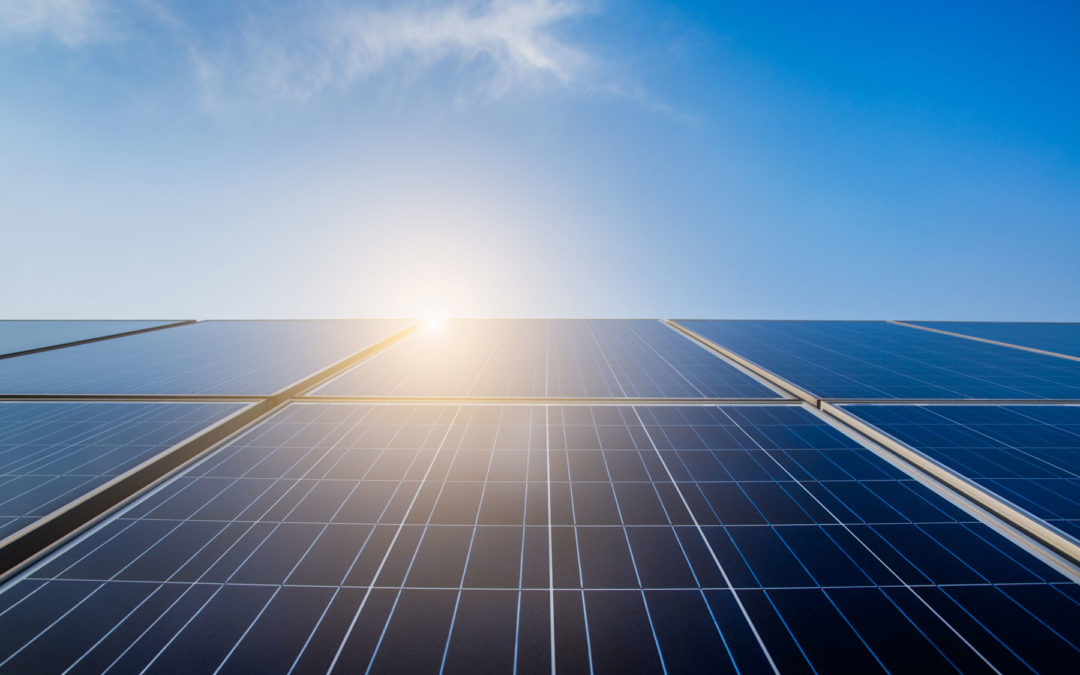
by Michael Vickerman | Nov 6, 2020 | Electric Vehicles, Energy Storage, Programs, Public Service Commission, Solar
Update: The Request for Proposals (RFP) pursuant to the 2020 grant cycle of the Energy Innovation Grant Program has been posted on the Public Service Commission’s web site. You can access the RFP here. The due date for grant submissions is January 22, 2021.
October 19, 2020
The Public Service Commission approved $7 million in funding that will be awarded through the 2020 round of the Energy Innovation Grant Program (EIGP). The EIGP awards financial assistance that supports the Office of Energy Innovation’s mission relating to energy efficiency, renewable energy, transportation, planning and resilience. In the previous round in 2018, the EIGP distributed nearly $5 million to more than 100 recipients. EIGP presently has a cash balance of more than $26 million.
The final order (PSC REF# 398392) was issued on October 16th, setting forth elements including (1) eligibility criteria; (2) eligible activities; (3) program budget; (4) procedures for tracking and reporting; and (5) development of the Request for Proposals (RFP).
The most important decisions rendered by the Commission are itemized below, interspersed with tables providing greater granularity on the program design and schedule.
Key decisions
- The following entities are eligible to seek funds through this program: manufacturers of all sizes; and cities, villages, towns, counties, K-12 school districts, tribes, municipal water and wastewater utilities, municipal electric utilities, municipal natural gas utilities, University of Wisconsin System campuses and facilities, Wisconsin Technical College System, public or nonprofit hospitals, and 501(3)(c) nonprofits (collectively MUSH Market).
- A budget of $7 million was authorized for the upcoming round. This represents an increase of $2 million from the previous round. The allocations for each of the four program activities are listed below.
- Projects involving all statutorily defined renewable energy resources are eligible for funding.
- The additional $2 million were allocated to Activities 1 and 2.
| Optional Available Funds Per Activity for 2020 Program Year |
| Activity |
Maximum grant request |
Available funds per activity |
| 1. Renewable Energy + Energy Storage |
22% up to $250,000
(solar PV only) |
$2.5 million |
| $500,000 (other RE) |
| $250,000 (energy storage system) |
| $500,000 (solar + storage) |
| $750,000 (other RE + storage) |
| 2. Energy Efficiency + Demand Response |
$1 million |
$3 million |
| 3. Electric + RNG Vehicles + Infrastructure |
$100,000 |
$1 million |
| 4. Comprehensive Energy Planning |
$100,000 |
$500,000 |
| Total |
|
$7 million |
The Commission also approved a timeline for the upcoming round of funding, the milestones of which appear in the table below.
| Tentative 2020 Energy Innovation Grant Program Year Timeline |
| Date |
Activity |
| 9/2020 |
PSC consideration of 2020 Grant Program Design – final order issued |
| 10/2020 |
Final order issued; Circulate RFP 90-day application period |
| 1/2021 |
Applications due |
| 2/2021 |
Review and score proposals |
| Spring 2021 |
2020 EIGP Award recommendations considered; announce awards |
| Spring 2021 |
Contract negotiations; sign award agreements |
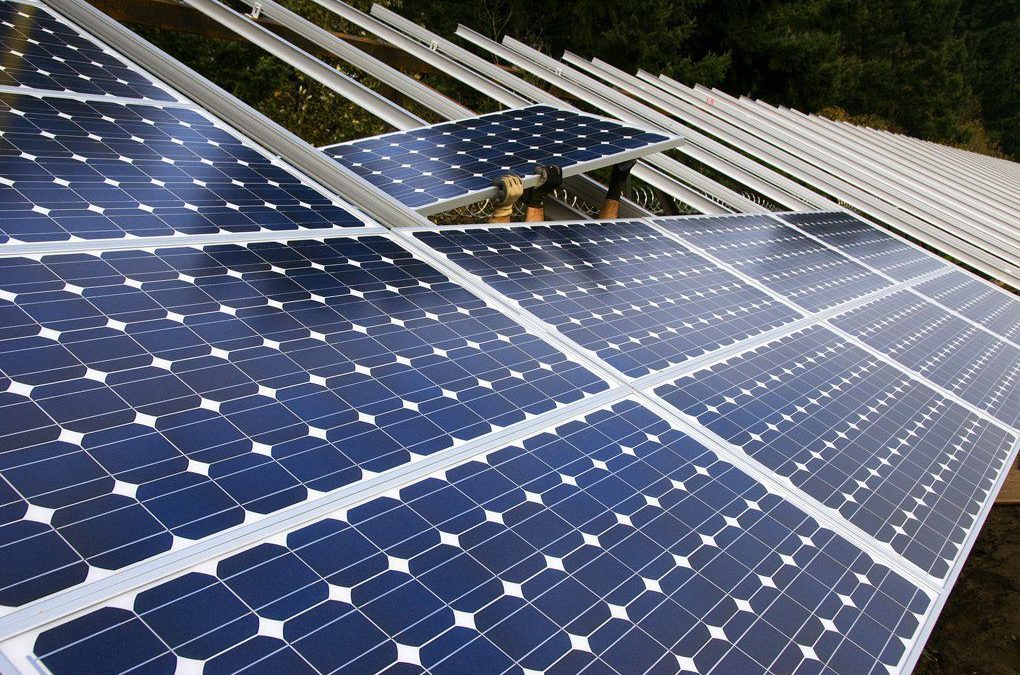
by Michael Vickerman | Oct 7, 2020 | Focus on Energy, PSC Priorities, Public Service Commission
Now entering its 20th year of operation, Wisconsin’s Focus on Energy program is widely recognized as a model public benefits program delivering energy savings to utility customers. This statewide program, funded entirely through utility bills, provides incentives and other services to help households, businesses, and nonprofits invest in energy efficiency measures and supply themselves with clean energy.
Take Capital Brewery as an example. With financial support from Focus on Energy, the Middleton brewery and beer garden installed in 2014 a high efficiency heat recovery system with controls and a 13 kilowatt (kW) solar electric system on its roof. Thanks to these investments, Capital Brewery saves more than $4,500 each year on its heating and electricity bills.
Capital Brewing’s Wisconsin peers are also capturing the energy value of sunshine. Breweries such as Central Waters, Ale Asylum, New Glarus, Bare Bones, and Lakefront have parlayed incentives from Focus on Energy into investments in onsite solar power. In so doing, they demonstrate that incorporating sustainability and carbon reduction into their operations is good business and can often be a competitive advantage.
According to its web site, Focus on Energy has enabled millions of ratepayers to save $730 million in avoided energy costs since the program’s inception. Moreover, it has been a consistently powerful economic engine for the state of Wisconsin, yielding between $4 and $5 in economic and avoided pollution benefits for every $1 spent by the program.
But to fully appreciate Focus on Energy’s reach and impact, it’s worth reading through the dozens of energy efficiency and clean energy success stories made possible by program incentives. As these testimonials and case studies make clear, Focus offerings have something of value for every electric customer in Wisconsin, no matter how large or small they may be.
On the renewable energy side, virtually every solar photovoltaic (PV) system powering Wisconsin residences and small businesses today received a rebate from this unique, ratepayer-funded program. Nowadays, with solar installation prices down to about a quarter of where they were 10 years ago, Focus on Energy can award rebates to many more customers than in the past. Notwithstanding the ongoing pandemic, 2020 is shaping up to be a record-breaking year in the residential solar market, fueled by $2.3 million in incentives from Focus on Energy.
The popularity of its solar incentives is putting a strain on Focus on Energy’s budget going into 2021. Under its current four-year plan, the program reserves $5.5 million each year for all qualifying renewable energy investments, out of an annual budget overall of about $95 million. Increasing its overall budget would require approval from state legislators. Absent such action, Focus on Energy has little choice but to pare residential rebate levels down to $500 per installation going forward.
Electric providers throughout Wisconsin contribute 1.2% of their gross revenues into Focus on Energy. Though they are not required to participate, all of the municipal utilities and nearly half of the electric cooperatives in Wisconsin also fund the program, to the tune of $8 a year per meter.
As the overseer of Focus on Energy, the Public Service Commission (PSC) is very mindful of the demands placed on the program, and its crucial contribution to reducing fossil energy consumption and greenhouse gas emissions. To that end, PSC Chair Rebecca Valcq is asking Governor Evers to put an additional $100 million into the program, starting in July 2021. According to the PSC, the increase would cost residential households less than a $1/month.
“These programs reduce emissions,” Valcq said. “They reduce the need to go out and look at building generation and transmission projects. These programs create jobs.”
Signed into law by Governor Tommy Thompson back in 1999, Focus on Energy has enjoyed strong bipartisan support throughout its history. Considering how broadly its benefits have been spread throughout the state, increasing the program’s budget should be something both Republicans and Democrats can agree on.
Michael Vickerman is policy director of RENEW Wisconsin
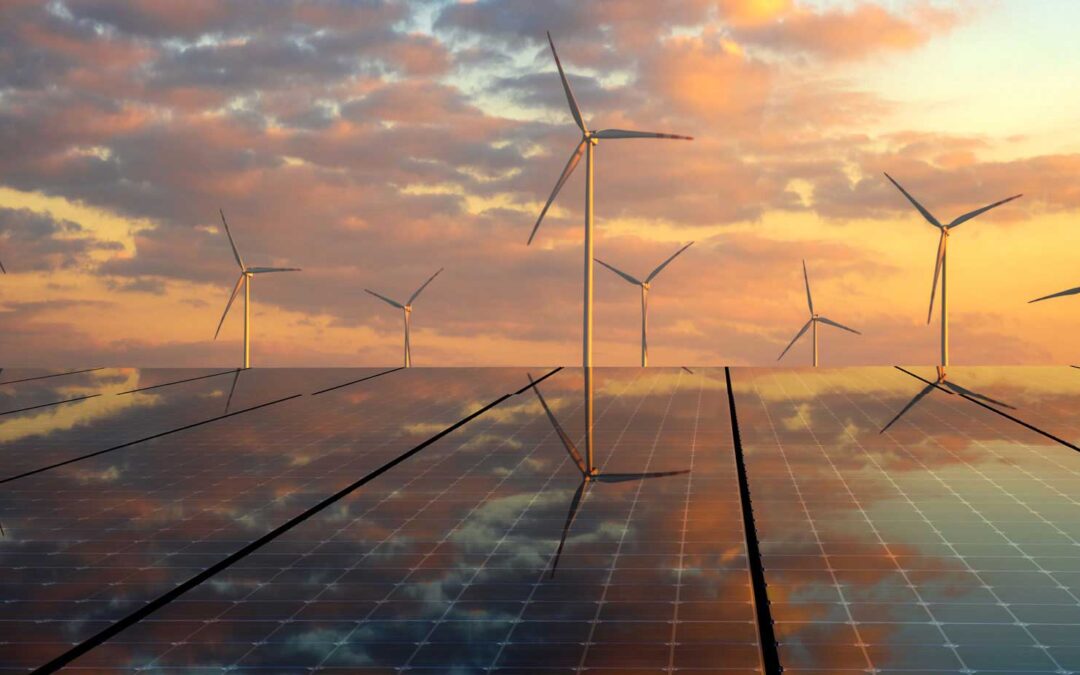
by Michael Vickerman | Aug 19, 2020 | Policy, Public Service Commission, RENEW Wisconsin
In June, the Public Service Commission requested public comments on the latest iteration of its Strategic Energy Assessment (SEA), a study that profiles the state’s electric power industry and surveys how the economic and regulatory landscape will likely evolve over the next six years. The PSC is required by law to update its assessment every two years. The PSC gave the public until August 14th to file comments to the draft study.
In contrast to previous renditions of this process, which were quiet affairs, this year’s draft assessment (Docket 5-ES-110) elicited a veritable torrent of comments from the public. This unprecedented volume of responses reflects a broadening understanding that electric providers are making significant changes to their resource mix to reduce carbon emissions, and that this clean energy transition must continue. With the PSC approving a significant quantity of zero-emission generation in other proceedings, it is heartening to see so many individuals and organizations encouraging the PSC to do more of the same.
Unfortunately, the draft SEA shies away from acknowledging the market realities and environmental constraints that are, today, driving utility procurement decisions quite clearly toward clean energy. This did not go unnoticed. As RENEW noted in its comments, the draft SEA is distinguished more by what is absent from the discussion than by the contents within it.
Chief among the blind spots is the document’s complete silence on climate science and the Governor’s Executive Orders #38 and #52, which enumerated a number of initiatives and goals to put the state on a zero-carbon pathway. Issued in August 2019, Executive Order #38 created a new office within state government, the Office of Sustainability and Clean Energy (OSCE). Over the last nine months, OSCE has been working closely with the Governor’s Task Force on Climate Change, assisting this body in formulating strategies for tackling the effects of climate change in Wisconsin.
OSCE director Maria Redmond submitted comments consisting of recommendations for improving the usefulness and educational value of the SEA.
While reporting on what the utility providers are doing, the PSCW should capitalize on the opportunity to integrate several multi-sector, local, state, and regional efforts to reduce energy consumption, transition to clean energy. The SEA compliments the work of the OSCE and could be a useful tool to measure and verify progress towards meeting our carbon reduction goals. The SEA could also be used to directly address and report on Wisconsin’s progress on reducing the impacts of climate change. As currently written, the assessment does not analyze the overall risks (business as usual) versus the benefits of the transition to a clean energy economy or addressing climate change.
RENEW struck a similar theme in its concluding remarks.
We encourage Commission staff to engage the newly created Office of Sustainability and Clean Energy in a productive way, and find other sources of information beyond the utility responses to data requests. Certainly, RENEW would, if asked, gladly assist Commission staff in the gathering of relevant information prior to the document-drafting process. As noted in the introduction, the Strategic Energy Assessment is the closest thing in the state to a public planning process involving the state’s electric providers. It’s crucially important that this and future iterations of the SEA weave in policy threads that will illuminate pathways to achieving the clean energy goals and objectives that numerous public and private entities in Wisconsin have adopted.
The breadth and volume of comments submitted to the PSC is directly attributable to RENEW’s work to engage stakeholders and the public on the current SEA, highlighted by a webinar organized and led by RENEW policy director Michael Vickerman. The webinar on July 14 presented a primer on the draft SEA, and provided suggested points that could be raised in comments. More than 50 individuals representing numerous organizations in Wisconsin and beyond registered for the webinar. The slide deck prepared for the webinar can be found here.
In 2018, a mere two weeks elapsed between the comment filing deadline and the issuance of the final SEA. This time around, we expect more significant re-writes and additions to the draft.
RENEW thanks the organizations and individuals who weighed in with comments. We are hopeful that the public response to the draft SEA will materialize into needed improvements in the final document.
by Jane McCurry | Jun 24, 2020 | Electric Vehicles, Programs, Public Service Commission, Utilities
On Thursday, June 18th the Wisconsin Public Service Commission (PSC) unanimously approved Xcel Energy’s three pioneering electric vehicle (EV) programs. Xcel, whose western Wisconsin service territory includes Eau Claire, La Crosse and Ashland, proposed two residential programs in addition to a commercial pilot program, all intended to reduce the upfront cost of installing electric vehicle charging infrastructure. These programs will make it easier and more affordable for individuals and businesses to install electric vehicle chargers and commit to driving electric.
In 2014, Madison Gas & Electric’s Charge@Home electric vehicle pilot program was approved by the PSC. Charge@Home launched in 2016, and like Xcel’s programs, it aims to help with the obstacles of EV adoption. Xcel’s two residential programs mark the first time a full-fledged electric vehicle program has been approved in Wisconsin.
Residential Programs
Under both of the residential programs, Xcel will install and maintain ownership of a level 2 charger on the customer’s property, provided the customer owns an electric vehicle. Customers will have the option of paying more upfront coupled with a lower monthly fee through their “pre-pay” option, or taking a “bundled” approach and paying more per month while foregoing the upfront charge. While customers will end up paying back the cost of the system over time, Xcel’s ownership of the charger means the expense of upkeep and replacement (if necessary) will be paid for by Xcel.
Under one of the programs, the electric vehicle charger will meter the electricity used to charge the car, which will be billed on its own EV-only time-of-use rate.* This means that customers can take advantage of the cost savings of charging their EV using inexpensive electricity overnight without having to switch their whole house to a time-of-use rate or install a second meter.
The second residential program is for customers who have on-site solar generation or who already use a time-of-use rate. This program is patterned after the first, except that the electric vehicle charging will not be put on its own rate. The whole home, including the EV charging, will be billed at Xcel’s existing residential time-of-use rate.
Commercial Pilot Program
Xcel will also run a commercial electric vehicle pilot program. In this pilot, Xcel will be studying an alternative to current line extension* rules. The utility will help customers finance the cost of make-ready infrastructure* needed for EV charging stations, which includes all necessary electrical equipment to operate the stations. Customers will pay the utility back over time as they use more electricity to charge their cars. The commercial customer would also have the option of letting Xcel own the charging stations, not just the make-ready, in which case the customer would pay an additional monthly fixed fee. These options will help commercial customers bring down what can sometimes be a very high upfront cost to install make-ready and charging infrastructure.
It can be expensive to install the equipment needed to recharge electric vehicle batteries, especially in commercial settings. We commend Xcel for finding creative solutions to some of the upfront cost barriers to electric vehicle ownership and deployment. These programs give Wisconsin customers more options for affordable electric vehicle charging and we’re excited to see the PSC approve them.
LINE EXTENSION • When the utility needs to add new electrical infrastructure to get electricity to a customer meter, it’s called a line extension. There are costs associated with adding this infrastructure, and approved formulas that help the utility calculate which costs the customer will pay.
MAKE-READY INFRASTRUCTURE • All of the electrical equipment up to (but not including) the EV charger. This includes wiring, conduit, electrical panel upgrades, and any other equipment or upgrades that are needed to place a functioning EV charger in the location.
TIME-OF-USE RATE • A time of use rate means that the amount you pay for electricity changes depending on the hour of the day and the day of the week. Typically, that means you pay more during daytime hours on weekdays, when it’s more expensive for the utility to generate and deliver that power, and less at night and on weekends, when the cost of supplying electricity to customers is significantly lower.
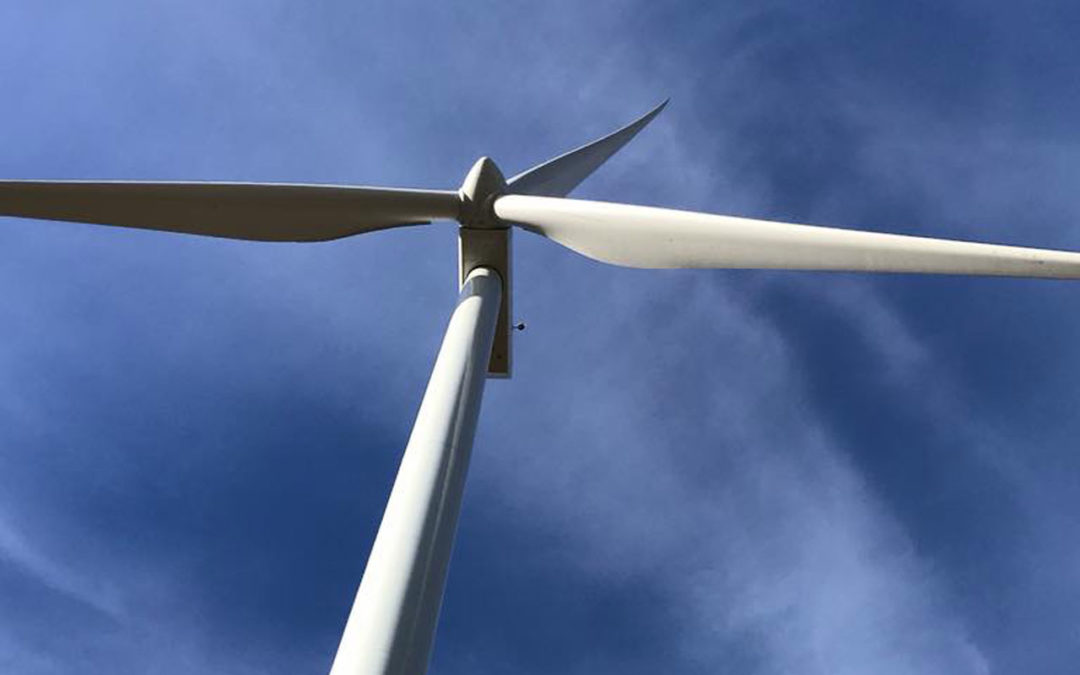
by Michael Vickerman | Jun 16, 2020 | Public Service Commission, Renewables, Utility Scale, Wind
In the first-ever test of the appeal process set forth in Wisconsin’s Wind Siting Rule (PSC 128), the Public Service Commission (PSC) reviewed and upheld Green County’s approval last fall of a 24-turbine, 65-megawatt (MW) wind project slated for development there. Following the county’s original decision, local wind farm opponents petitioned the PSC to invalidate the project’s permit, contending that the developer’s application was incomplete.
On June 11, the PSC denied the petition on a 3-0 vote, and in so doing removed the last remaining legal obstacle from the project’s path. As it stands today, the Sugar River wind farm is fully compliant with the standards set forth in the statewide rule relating to public health and safety, and may now proceed to construction.
Advanced by EDF Renewables, a nationally prominent renewable energy producer, Sugar River is capable of generating enough electricity to equal the consumption of 20,000 Wisconsin households. When operational, Sugar River will also yield about $260,000 in annual revenues, with nearly $152,000 going to Green County and more than $108,000 to the Town of Jefferson. Before ground can be broken, however, EDF will need to either sign a power purchase agreement with an off-taker or agree to sell the wind farm to an electric provider when construction is complete.
Sugar River was one of the first two wind energy proposals in 2019 to go through the local government review process specified in PSC 128. The other proposed wind farm, the 99 MW Red Barn project in Grant County, secured a conditional use permit in July 2019. No appeal of Grant County’s decision was filed. Like Sugar River, Red Barn is expecting to begin operation in the second half of 2021, assuming a partnership has been forged with an electric provider.
Sugar River provided the first significant test of PSC 128 after the rule narrowly survived a repeal vote during the 2011-2012 legislative session. The rule establishes a mechanism whereby a citizen group or a development company may challenge a local government decision on a proposed wind farm. Under this appeal process, the PSC’s role is to ascertain whether the local government adhered to all the standards and procedures in rendering a decision on a wind farm proposal.
In the case of Sugar River, the PSC agreed to take up the appeal filed by No Green County Wind in October 2019. Before rendering its decision, the PSC invited interested parties to submit comments on the matter. In its comments, RENEW expressed its support for the Sugar River project, as well as the regulatory framework that allowed the project to be given a fair hearing at every step of its permitting journey. The PSC plans to issue a written decision in July.
The approvals of Sugar River and Red Barn signal the end of a protracted lull in wind development activity lasting from 2011 to 2017. Between an adverse political environment and a glut of generating capacity, wind energy development stalled in Wisconsin. During the dry spell here, developers flocked to greener pastures in neighboring states. The door reopened slightly when Dairyland Power Cooperative agreed to purchase electricity generated from Quilt Block Wind Farm, which started operating in November 2017.
Though local opposition to wind development remains very much alive today, the experience with Sugar River attests to the strength and durability of Wisconsin’s Wind Siting Rule, which foretokens brighter days for the wind power industry here.
To learn more about the Sugar River Wind Farm, visit these previous blog posts.
PSC affirms local approval of Sugar River Wind Farm
Local Residents Discuss Wind Energy in Wisconsin
A Scientific Look into Wind Power and Human Health





